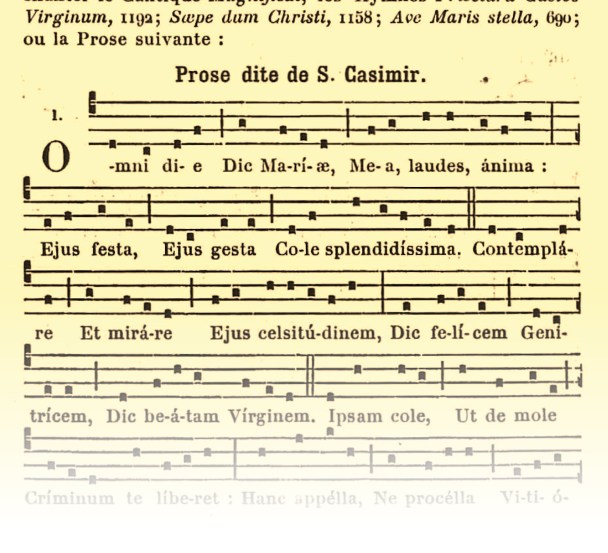 Y COLLEAGUE, Patrick Williams, has given me permission to share with our audience a recording his choir made of “Daily, Daily, Sing to Mary.” This famous metrical hymn is known as THE HYMN OF SAINT CASIMIR. In 2015, I wrote a massive article about this hymn’s provenance. I won’t repeat what I said there, because this hymn has such an elaborate history it could easily serve as the basis for a dozen dissertations. Roman Catholic translators—who changed the hymn into English, Polish, Greek, French, Spanish, Italian, and Hungarian—miraculously kept the original rhyme scheme!
Y COLLEAGUE, Patrick Williams, has given me permission to share with our audience a recording his choir made of “Daily, Daily, Sing to Mary.” This famous metrical hymn is known as THE HYMN OF SAINT CASIMIR. In 2015, I wrote a massive article about this hymn’s provenance. I won’t repeat what I said there, because this hymn has such an elaborate history it could easily serve as the basis for a dozen dissertations. Roman Catholic translators—who changed the hymn into English, Polish, Greek, French, Spanish, Italian, and Hungarian—miraculously kept the original rhyme scheme!
“Non Sint In Vobis Schismata” • Readers may have noticed I don’t necessarily “see eye to eye” with Mæstro Williams when it comes to plainsong rhythm. We have attempted to share these arguments with readers in the Gregorian Rhythm Wars series. Musicians often struggle to remain charitable when they have disagreements. We’re attempting to demonstrate that it’s possible to disagree without being disagreeable—please pray for us! In any event, it’s crucial to find areas of agreement where possible. I would like to say that I think Patrick’s recording (below) is praiseworthy:
* Mp3 Download • “Daily, Daily, Sing to Mary”
—Live recording directed by Patrick Williams.
Other Sources • Abbat Pothier’s Latin/French “Liber Usualis” (1896) includes a plainsong version of this hymn. There can be more than one good harmonization for a hymn melody. The Brébeuf Hymnal harmonization (#768) is excellent. [It can be found in the organ accompaniment volume or the choral supplement.] I’m not sure which harmonization Patrick used. The Brébeuf Hymnal also includes a “text only version,” meaning you can sing the lyrics to a different tune. By the way, someone in Spain has made a nice recording of the Latin version, and it’s interesting to hear how the singer pronounces the letter “G.” The metrical tune commonly chosen has various names, including “SUNRISE” and “LAUDES MARIAE.” Believe it or not, the hymn tune called “DAILY DAILY” is a completely different melody.
Laudate Hymnal (1942) • The Laudate Hymnal (1942) by Father Andrew Green, OSB, uses the “LAUDES MARIAE” melody for a Christmas text:
Mediator Dei Hymnal (1955) • Joseph Vincent Higginson, in his “Mediator Dei Hymnal” (1955)—which he published under the fake name of “Cyr De Brant”—adds a passing tone. Otherwise, the melody is identical.
New Saint Basil Hymnal (1958) • When it comes to “The New Saint Basil Hymnal” (1958) published by Edward C. Currie, I have serious doubts about the athletic line given to the bass section towards the end:
Dr. Theodore Marier Hymnal • Notice how Dr. Theodore Marier uses the “LAUDES MARIAE” melody for two different texts, and neither is the Hymn of Saint Casimir:
Conclusion • It’s important to cultivate a love for Mary, the mother of Jesus. The Jesuit Martyrs of North America—Brébeuf, Lalemant, Jogues, Goupil, Lalande, Daniel, Garnier, and Chabanel—each had a strong, ardent, powerful devotion to the Blessed Mother. Their main base of operations was named in her honor: “Sainte-Marie among the Hurons.”
![]()
![]()


